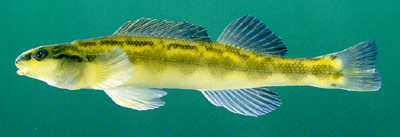Gilmer County and the greater Blue Ridge of Georgia were featured in two articles in the current edition of Southeastern Naturalist. It’s a scientific journal about research throughout the Deep South. One article is a fascinating look into a tiny fish that survives as a species in two small localities – one in Alabama and one here in the upper Coosawattee River, including Mountaintown Creek.
The Goldline Darter (Percina aurolineata Suttkus and Ramsey) is a small fish that most of us would mistake for fish bait.

Not even four inches long, these little guys make their homes in small streams and rivers in the upper reaches of the Cahaba River of Alabama and the Coosawattee River of northern Georgia. The Georgia range of the Goldline Darter appears to be limited to some waterways upstream of Carters Dam. They thrive in shallow streams in which they can live over sand-to-gravel beds and can nest downstream of boulders. However, they’re also considered to be an endangered species by the state of Georgia and a threatened species by Federal wildlife officials.
Did that sort of stream sound familiar? It ought to. Researchers at Roanoke College, in Virginia, and the Tennessee Aquarium Conservation Institute recently published an article in Southeastern Naturalist to discuss their research into the Goldline Darter population that lives in several Gilmer County streams, to include Mountaintown Creek at the Highway 52 (Chatsworth Highway) bridge. The scientists collected fish samples from Mountaintown Creek and other Gilmer creeks to answer questions about whether the Alabama and Coosawattee populations were separate species and whether any conservation plan should lump the two populations or preserve them separately.
The authors discussed how the current thinking is that the Goldline Darter was once a widespread species in the Alabama River, into which Mountaintown Creek eventually leads via the Coosawattee River. A combination of damming (Carters Lake, for example) and pollution probably eliminated them from all but the most remote tributaries, including Mountaintown. The authors did a genetic analysis of tissue from darters that were collected around Mountaintown and other nearby creeks, as well as from darters in the Alabama population. The results: the local darters are closely related enough to the Alabama population that they should be considered members of the same species. However, there is enough genetic separation between them that any conservation plan should try to preserve both populations without co-mingling them.
Have we seen any here? We’re not sure. We first spotted some fish that were very similar to Goldline Darters in East Mountaintown Creek back in December, 2015 (thank goodness for my journal notes!). We’re aren’t fish experts by any means, though, so we might check in with the researchers to see if we can determine exactly what we saw. To be continued….
______
Want to learn more?
Some sources that I reviewed include:
2. Straight, C.A., B. Albanese, and B.J. Freeman. [Internet]. [updated 2009 March 25]. Fishes of Georgia Website, Georgia Museum of Natural History, cited January 13, 2016. Available from: http://fishesofgeorgia.uga.edu
